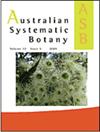澳洲西南部毒伞科毒伞科毒伞科砂伞科的新增内容
IF 1.6
3区 生物学
Q4 EVOLUTIONARY BIOLOGY
引用次数: 3
摘要
摘要鹅膏菌最近的分子系统发育鉴定出三个亚属和11个部分。鹅膏菌亚属的成员具有淀粉样孢子和菌根习性。Arenariae部分属于这个亚属。本节成员仅来自澳大利亚南部;它们要么是螯合的(secotioid),要么是无神经节的,并且缺乏夹紧连接。我们描述了以下三个额外的secotioid物种:Amanita arenarioides Bougher,E.M.Davison&Giustiano,A.compacta Bougher、E.M.Davison&Giustiniano和A.pseudoarenaria E.M.Davisson,Giustinino&Bougher。它们在宏观外观、孢子形状和遗传序列上是分离的。我们还描述了两个无翅目物种,即A.pumptuju E.M.Davison、Giustiano、McGurk&E.L.J.Watkin和A.sabulosa E.M.Davison&Giustianno,它们在球茎形状和遗传序列上是分开的。我们提供了A.arenaria(O.K.Mill.&E.Horak)Justo和A.griseloides D.A.Reid的详细描述;我们还将A.dumosorum D.A.Reid与A.peltigera D.A.Reid.同义。提供了Arenariae部分的修订诊断和描述,以及该部分目前公认成员的钥匙。本文章由计算机程序翻译,如有差异,请以英文原文为准。
Additions to Amanita (Amanitaceae, Agaricales) section Arenariae from south-western Australia
Abstract. A recent molecular phylogeny of Amanita recognises three subgenera and 11 sections. Members of subgenus Amanitina are characterised by amyloid spores and a mycorrhizal habit. Section Arenariae falls within this subgenus. Members of this section are known only from southern Australia; they are either sequestrate (secotioid) or agaricoid and lack clamp connections. We describe the following three additional secotioid species: Amanita arenarioides Bougher, E.M.Davison & Giustiniano, A. compacta Bougher, E.M.Davison & Giustiniano and A. pseudoarenaria E.M.Davison, Giustiniano & Bougher, which are separated on macroscopic appearance, spore shape and genetic sequences. We also describe two agaricoid species, namely, A. pupatuju E.M.Davison, Giustiniano, McGurk & E.L.J.Watkin, and A sabulosa E.M.Davison & Giustiniano, which are separated on bulb shape and genetic sequences. We provide expanded descriptions of A. arenaria (O.K.Mill. & E.Horak) Justo and A. griselloides D.A.Reid; we also synonymise A. dumosorum D.A.Reid with A. peltigera D.A.Reid. A revised diagnosis and description of section Arenariae is provided, together with a key to currently recognised member of this section.
求助全文
通过发布文献求助,成功后即可免费获取论文全文。
去求助
来源期刊

Australian Systematic Botany
生物-进化生物学
CiteScore
3.10
自引率
12.50%
发文量
12
审稿时长
>12 weeks
期刊介绍:
Australian Systematic Botany is an international journal devoted to the systematics, taxonomy, and related aspects of biogeography and evolution of all algae, fungi and plants, including fossils. Descriptive taxonomic papers should normally constitute a comprehensive treatment of a group. Short papers on individual species and nomenclatural papers must contain significant new information of broader interest to be considered. The prestigious L.A.S. Johnson Review Series is published. Other review articles will also be considered. All papers are peer reviewed.
Australian Systematic Botany is published with the endorsement of the Commonwealth Scientific and Industrial Research Organisation (CSIRO) and the Australian Academy of Science.
 求助内容:
求助内容: 应助结果提醒方式:
应助结果提醒方式:


